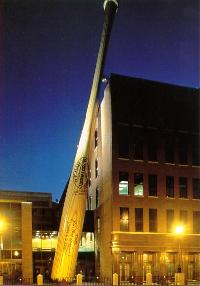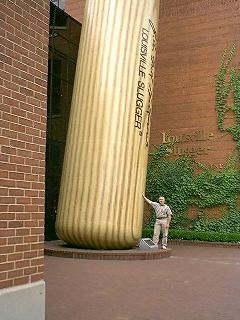|
Woodworker Wanderings - Louisville Slugger
By: Doug Bittinger © June
2000
One of the most popular summertime activities in America is
baseball. Whether you're a player or a fan,
nothing says 'baseball' better than the distinctive
crack of the bat as it sends the ball soaring.
Any serious wood turner has at least dreamt of turning a ball
bat, and probably pondered where and how this icon of the
Great American Game is made. I am no exception and my
wife and I recently had the privilege of visiting the factory
where the Louisville Slugger baseball bats
are produced. 
The Louisville Slugger headquarters is a 5 story brick
building a couple of blocks from the waterfront, at Eighth
& Main streets in Louisville Kentucky. It is hard
to miss due to the company's logo, which leans against
the building in their entry courtyard. It's a 120
foot tall, 9 foot diameter baseball bat weighing 64,000
pounds: the largest baseball bat in the world. The building
it leans against houses their main offices, the factory where
all their wooden bats are made, and a baseball museum.
Tours are provided of the museum and factory.
After watching a short movie narrated by James Earl Jones
which covers the historical highlights of baseball, visitors
proceed through an underground locker room and dug out to
peruse a collection of baseball memorabilia which pays
tribute to famous players and broadcasters of the sport.
One, smaller room displays the stream powered turning
lathe and turning tools used by our forebears to produce bats
for the early players. 
The factory tour begins in a display room showing the three
ways that baseball bat billets -- or what we'd call
turning blanks -- are produced. Northern white ash
trees are felled and their trunks cut into 43" lengths.
These logs are then either split into wedges using a
hydraulic maul, sawn into squares using a buzzsaw, or cored
using a device like a 43" deep hole saw. Billets
produced by the first two methods are chucked into a lathe
and rounded off using a chainsaw like grinder head that
rounds the entire blank at one time. These billets are
stacked, strapped and shipped to Louisville.
The Hillerich & Bradsby Co., manufacturers of the
Louisville Slugger and other types of sporting equipment,
produces over 160 different models of wooden baseball bats at
this facility, over 1 million bats per year.
They use three types of lathe to do this. The first is
a typical production duplicator lathe using a water cooled,
carbide cutting head that shapes the entire bat in one pass
taking about 30 seconds and leaves a relatively smooth
surface. The next uses multiple cutter heads --
similar to 4 " diameter circular saw blades to grind the
billet into shape in an amazing 15 seconds, but it leaves a
pretty rough surface. The third is a back-knife lathe
which uses a long curved blade similar to that of a paper
cutter to slice out the final shape of the bat in a single 15
second pass, leaving a very smooth surface that needs very
little finish sanding.
Carts full of the turned bats are rolled to a band saw
operator who trims the stubs from both ends of the bat and
sands the ends smooth. Then the bats have the company
logo and model numbers burned into them by a huge electric
branding iron that holds the bat against the heated branding
plate and rolls the bat with just the right amount of speed
and pressure to produce a perfectly burned logo.
The bats then pass through a bulk sander that smooths the
barrels and removes the surface discoloration left from the
branding process. The end of this process is a rolling
pass through a gas flame that 'tempers' the bat.
I don't know that this toasting actually changes
the strength of the bat, but it does bring out the
distinctive grain pattern of the Ash.
Each bat is then hand dipped in a vat of lacquer and hung on
a rack to pass through a drying oven.
All that remains now is to wrap the handle with tape, and
seal the finished bat in a protective sleeve for shipping.
Unfortunately, taking photographs in the factory is
prohibited, but unlike some factory tours, visitors are right
there next to the machines, able to see everything going on.
Plexiglass shields keep the foolish from losing body
parts, but you couldn't ask for a more up-close and
personal look at some fascinating turning equipment.
So, next time you're in the Louisville area, plan to set
aside an hour or so and visit the baseball museum and
factory. They're open Mon.- Sat. 9-5, the last
tour begins 1 hour before closing. For a preview, you
can visit their web site for a virtual tour.
When you get back, I guarantee you'll be heading for your
local Rockler Woodworking and Hardware store to pick up a bat
blank or two!
Till next time!
|